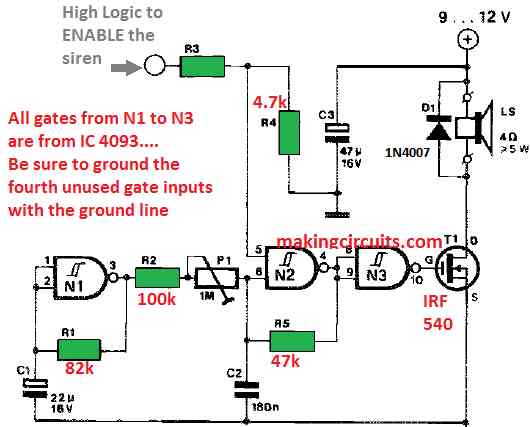You might have come across may great siren circuits from this website, however this siren circuit has its own advantages such as a high gain and high power output along with an adjustable frequency rate.
All kinds of circuit designs that produce audible frequency are seemingly more popular with readers.
A very obvious reason for the same is because the correct circuit operation is verified audibly and with no need for test equipment. In simpler words, the circuit functions something in physical sense.

This specific type of high power single IC siren is simple and easy to get constructed as it is built around only one IC that is LM 389 from National Semiconductors. The LM 389 contains an audio power amplifier that is similar to the LM 386 with three uncommitted NPN transistors.
A basis of a stable multivibrator is formed with a frequency variable between 1 and 7 Hz with the two transistors T1 and T2. The P1 is used to adjust the same. With a frequency variable between 250 Hz and 1500 Hz output generated by the loudspeaker, this amplifier can also be configured as a squarewave oscillator.
Though, the amplifier is functioned by the multivibrator via transistor T3. This results in a pulsed siren like sound whose audible frequency can be changed by preset P2.
Powerful Siren using NAND Gates
Looks can be deceiving. That is proven in this power packed siren circuit which appears simple yet packs a serious punch. The reason is because of the n-channel MOSFET, T1, which empowers the loudspeaker with a high output sound.

This type of MOSFET is capably controlled by CMOS logic circuits. The type of circuit selected in this project equips an output (drain-source) resistance of around 3 ohms.
Furthermore, the drain current can reach up to 1.7 A whereas the maximum drain-source voltage is 40 V. These values are there regardless of the polarity of the supplied voltage as the component occupies internal diode protection.
The power handling capacity of the MOSFET is extremely high and due to that, you can load it with just a loudspeaker. Even a computer can be used to control the circuit by toggling the ENABLE input logic high.
This is also possible by means of a switch rather than a computer. Once the input at pin 5 of gate N2 is high, the pulsations from N1 (Schmitt trigger) cause N2 to oscillate. Through buffer N3, N2’s output is affixed to the MOSFET. After that, using P1, you can regulate the frequency of N2.
The most common application for this CMOS NAND gate siren circuit is in powerful alarm systems.
Hello.
The second circuit does not indicate the value of R3 and the integrated power supply. Can you indicate these?
you can use a 1k there….
I am looking for an AC/DC[from 2voltsand from2 millamps – Wattmeter project that can be used on digital meter Re 7 segment display
sorry we don’t have a wattmeter circuit with us at this moment….
I am looking for an AC/DC[from 2voltsand from2 millamps – Wattmeter project that can be used on digital meter Re 7 segment display
Presently I do not have it, but I will try to search for it in my electronic circuit collections, and let you know now if I have one there